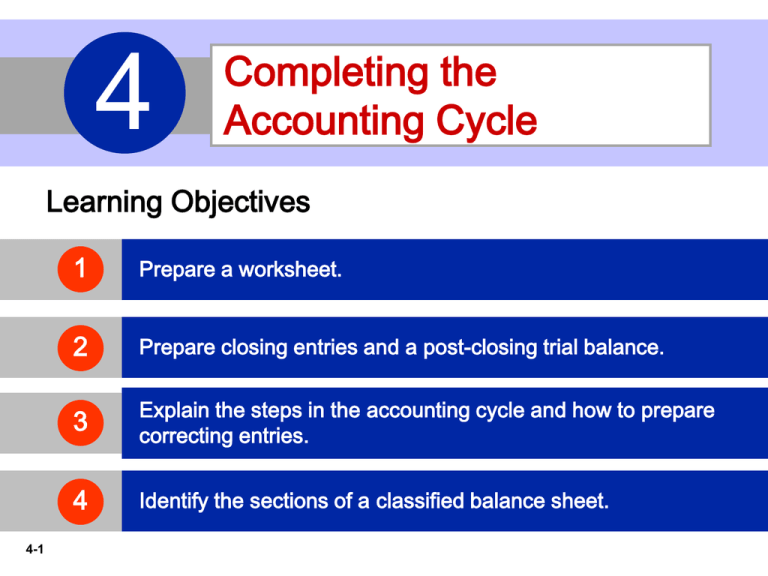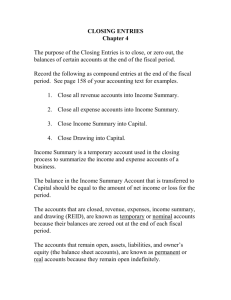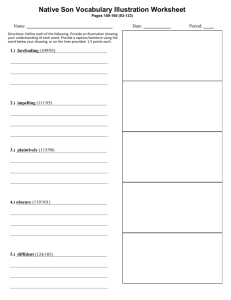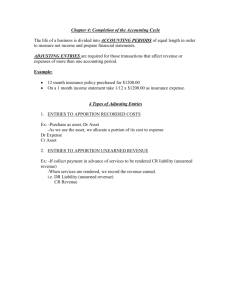
4
Completing the
Accounting Cycle
Learning Objectives
4-1
1
Prepare a worksheet.
2
Prepare closing entries and a post-closing trial balance.
3
Explain the steps in the accounting cycle and how to prepare
correcting entries.
4
Identify the sections of a classified balance sheet.
LEARNING
OBJECTIVE
1
Prepare a worksheet.
Worksheet
Multiple-column form used in preparing financial
statements.
Not a permanent accounting record.
May be a computerized worksheet using an electronic
spreadsheet program such as Excel.
4-2
Prepared using a five step process.
Use of worksheet is optional.
LO 1
Steps in Preparing a Worksheet
Illustration 4-1
4-3
Steps in Preparing a Worksheet
Illustration 4-2
STEP 1: PREPARE A TRIAL BALANCE ON THE WORKSHEET
Cash
Supplies
Prepaid Insurance
Equipment
Notes Payable
Accounts Payable
Unearned Revenue
Owner's Capital
Owner's Drawings
Service Revenue
Trial Balance
Dr.
Cr.
15,200
2,500
600
5,000
5,000
2,500
1,200
10,000
500
10,000
Salaries and Wages Exp.
Rent Exp.
Totals
4,000
900
28,700
Account Titles
Adjustments
Dr.
Cr.
Adjusted
Trial Balance
Dr.
Cr.
Income
Statement
Dr.
Cr.
Balance Sheet
Dr.
Cr.
28,700
Trial balance amounts come
directly from ledger accounts.
Include all accounts
with balances.
4-4
LO 1
Steps in Preparing a Worksheet
Illustration 3-23
General journal
showing adjusting
entries
Adjusting
Journal
Entries
(Chapter 3)
4-5
LO 1
Steps in Preparing a Worksheet
Illustration 4-3
STEP 2: ENTER THE ADJUSTMENTS IN THE ADJUSTMENTS COLUMNS
Account Titles
Cash
Supplies
Prepaid Insurance
Equipment
Notes Payable
Accounts Payable
Unearned Revenue
Owner's Capital
Owner's Drawings
Service Revenue
Salaries and Wages Exp.
Rent Exp.
Totals
Supplies Expense
Insurance Expense
Accumulated Depreciation
Depreciation Expense
Accounts Receivable
Interest Expense
Interest Payable
Salaries and Wages Payable
Totals
Trial Balance
Adjustments
Dr.
Cr.
Dr.
Cr.
15,200
(a) 1,500
2,500
(b)
600
50
5,000
5,000
2,500
1,200 (d) 400
10,000
500
(d) 400
10,000
(e) 200
(g)
4,000
1,200
900
28,700
28,700
(a) 1,500
(b) 50
(c)
40
(c) 40
(e) 200
(f)
50
(f)
50
(g) 1,200
3,440
3,440
Add additional accounts as needed.
4-6
Adjusted
Trial Balance
Dr.
Cr.
Income
Statement
Dr.
Cr.
Balance Sheet
Dr.
Cr.
Adjustments Key:
(a) Supplies Used.
(b) Insurance Expired.
(c) Depreciation Expensed.
(d) Service Revenue Recognized.
(e) Service Revenue Accrued.
(f) Interest Accrued.
(g) Salaries Accrued.
Enter adjustment amounts, total
adjustments columns,
and check for equality.
LO 1
Steps in Preparing a Worksheet
Illustration 4-4
STEP 3: COMPLETE THE ADJUSTED TRIAL BALANCE COLUMNS
Account Titles
Cash
Supplies
Prepaid Insurance
Equipment
Notes Payable
Accounts Payable
Unearned Revenue
Owner's Capital
Owner's Drawings
Service Revenue
Salaries and Wages Exp.
Rent Exp.
Totals
Supplies Expense
Insurance Expense
Accumulated Depreciation
Depreciation Expense
Accounts Receivable
Interest Expense
Interest Payable
Salaries and Wages Payable
Totals
Net Income
Totals
Total
4-7
Trial Balance
Adjustments
Dr.
Cr.
Dr.
Cr.
15,200
(a) 1,500
2,500
(b)
600
50
5,000
5,000
2,500
1,200 (d) 400
10,000
500
(d) 400
10,000
(e) 200
(g)
4,000
1,200
900
28,700
28,700
(a) 1,500
(b) 50
(c)
40
(c) 40
(e) 200
(f)
50
(f)
50
(g) 1,200
3,440
3,440
the adjusted trial balance
columns and check for equality.
Adjusted
Trial Balance
Dr.
Cr.
15,200
1,000
550
5,000
5,000
2,500
800
10,000
500
10,600
Income
Statement
Dr.
Cr.
Balance Sheet
Dr.
Cr.
5,200
900
1,500
50
40
40
200
50
30,190
50
1,200
30,190
LO 1
Steps in Preparing a Worksheet
Illustration 4-5
STEP 4: EXTEND AMOUNTS TO FINANCIAL STATEMENT COLUMNS
Account Titles
Cash
Supplies
Prepaid Insurance
Equipment
Notes Payable
Accounts Payable
Unearned Revenue
Owner's Capital
Owner's Drawings
Service Revenue
Trial Balance
Adjustments
Dr.
Cr.
Dr.
Cr.
15,200
(a) 1,500
2,500
(b)
600
50
5,000
5,000
2,500
1,200 (d) 400
10,000
500
(d) 400
10,000
(e) 200
(g)
4,000
1,200
900
28,700
28,700
(a) 1,500
(b) 50
(c)
40
(c) 40
(e) 200
(f)
50
(f)
50
(g) 1,200
3,440
3,440
Salaries and Wages Exp.
Rent Exp.
Totals
Supplies Expense
Insurance Expense
Accumulated Depreciation
Depreciation Expense
Accounts Receivable
Interest Expense
Interest Payable
Salaries and Wages Payable
Totals
Net Income
Totals
Extend
4-8
Adjusted
Trial Balance
Dr.
Cr.
15,200
1,000
550
5,000
5,000
2,500
800
10,000
500
10,600
Income
Statement
Dr.
Cr.
Balance Sheet
Dr.
Cr.
15,200
1,000
550
5,000
5,000
2,500
800
10,000
500
10,600
5,200
900
5,200
900
1,500
50
1,500
50
40
40
200
50
30,190
adjusted trial balance amounts to
appropriate financial statement columns.
40
40
200
50
50
1,200
30,190
7,740
10,600
22,450
50
1,200
19,590
LO 1
Steps in Preparing a Worksheet
Illustration 4-6
STEP 5: TOTAL COLUMNS, COMPUTE NET INCOME (LOSS)
Account Titles
Cash
Supplies
Prepaid Insurance
Equipment
Notes Payable
Accounts Payable
Unearned Revenue
Owner's Capital
Owner's Drawings
Service Revenue
Salaries and Wages Exp.
Rent Exp.
Totals
Supplies Expense
Insurance Expense
Accumulated Depreciation
Depreciation Expense
Accounts Receivable
Interest Expense
Interest Payable
Salaries and Wages Payable
Totals
Net Income
Totals
4-9
Trial Balance
Adjustments
Dr.
Cr.
Dr.
Cr.
15,200
(a) 1,500
2,500
(b)
600
50
5,000
5,000
2,500
1,200 (d) 400
10,000
500
(d) 400
10,000
(e) 200
(g)
4,000
1,200
900
28,700
28,700
(a) 1,500
(b) 50
(c)
40
(c) 40
(e) 200
(f)
50
(f)
50
(g) 1,200
3,440
3,440
Adjusted
Trial Balance
Dr.
Cr.
15,200
1,000
550
5,000
5,000
2,500
800
10,000
500
10,600
Income
Statement
Dr.
Cr.
Balance Sheet
Dr.
Cr.
15,200
1,000
550
5,000
5,000
2,500
800
10,000
500
10,600
5,200
900
5,200
900
1,500
50
1,500
50
40
40
200
50
30,190
Compute Net Income or Net Loss.
40
40
200
50
50
1,200
30,190
7,740
2,860
10,600
10,600
22,450
10,600
22,450
50
1,200
19,590
2,860
22,450
LO 1
Steps in Preparing a Worksheet
Question
Net income is shown on a worksheet in the:
a. income statement debit column only.
b. balance sheet debit column only.
c. income statement credit column and balance sheet
debit column.
d. income statement debit column and balance sheet
credit column.
4-10
LO 1
Preparing Financial Statements from a
Worksheet
4-11
Income statement is prepared from the income statement
columns.
Balance sheet and owner’s equity statement are
prepared from the balance sheet columns.
Companies can prepare financial statements before they
journalize and post adjusting entries.
LO 1
Preparing Statements from a Worksheet
Illustration 4-7
Financial statements
from a worksheet
4-12
LO 1
Preparing Statements from a Worksheet
Illustration 4-7
Financial statements
from a worksheet
4-13
LO 1
Illustration 4-7
4-14
LO 1
Preparing Adjusting Entries from a
Worksheet
4-15
Adjusting entries are prepared from the adjustments
columns of the worksheet.
Journalizing and posting of adjusting entries follows the
preparation of financial statements when a worksheet is
used.
LO 1
DO IT! 1
Worksheet
Susan Elbe is preparing a worksheet. Explain to Susan how she
should extend the following adjusted trial balance accounts to the
financial statement columns of the worksheet.
4-16
Cash
Balance sheet (debit column)
Accumulated Depreciation
Balance Sheet (credit column)
Accounts Payable
Balance Sheet (credit column)
Owner’s Drawings
Balance sheet (debit column)
Service Revenue
Income statement (credit column)
Salaries and Wages Expense
Income statement (debit column)
LO 1
LEARNING
OBJECTIVE
2
Prepare closing entries and a post-closing
trial balance.
At the end of the accounting period, the company makes
the accounts ready for the next period.
Illustration 4-8
Temporary versus permanent accounts
4-17
LO 2
Preparing Closing Entries
Closing entries formally recognize in the ledger the transfer of
net income (or net loss) and
owner’s drawings
to owner’s capital.
Companies generally journalize and post closing entries only at
the end of the annual accounting period.
Closing entries produce a zero balance in each temporary
account.
4-18
LO 2
Preparing Closing Entries
Illustration 4-9
Diagram of closing
process—proprietorship
Owner’s Capital is a
permanent account. All
other accounts are
temporary accounts.
4-19
LO 2
Preparing Closing Entries
CLOSING
ENTRIES
ILLUSTRATED
4-20
Illustration 4-10
Closing entries
journalized
Posting
Closing
Entries
Illustration 4-11
4-21
LO 2
4-22
LO 2
Preparing a Post-Closing Trial Balance
Purpose is to prove the equality of the permanent account balances
carried forward into the next accounting period.
Illustration 4-12
Post-closing trial balance
4-23
LO 2
DO IT! 2
Closing Entries
The worksheet for Hancock Company shows the following in the
financial statement columns:
Owner’s Drawings
$15,000
Owner’s Capital
$42,000
Net income
$18,000
Prepare the closing entries at December 31 that affect owner’s
capital.
Income Summary
18,000
Owner’s Capital
Owner’s Capital
Owner’s Drawings
4-24
18,000
15,000
15,000
LO 2
LEARNING
OBJECTIVE
3
Explain the steps in the accounting cycle and
how to prepare correcting entries.
Illustration 4-15
1. Analyze business transactions
4-25
9. Prepare a post-closing trial
balance
2. Journalize the transactions
8. Journalize and post closing
entries
3. Post to ledger accounts
7. Prepare financial statements
4. Prepare a trial balance
6. Prepare an adjusted trial
balance
5. Journalize and post
adjusting entries
LO 3
Correcting Entries—An Avoidable Step
Unnecessary if accounting records are free of errors.
Made whenever an error is discovered.
Must be posted before closing entries.
Instead of preparing a correcting entry, it is possible to
reverse the incorrect entry and then prepare the correct entry.
4-26
LO 3
Correcting Entries—An Avoidable Step
CASE 1: On May 10, Mercato Co. journalized and posted a $50 cash
collection on account from a customer as a debit to Cash $50 and a
credit to Service Revenue $50. The company discovered the error on
May 20, when the customer paid the remaining balance in full.
Incorrect
entry
Cash
Correct
entry
Cash
Correcting
entry
4-27
50
Service Revenue
50
50
Accounts Receivable
Service Revenue
Accounts Receivable
50
50
50
LO 3
Correcting Entries—An Avoidable Step
CASE 2: On May 18, Mercato purchased on account equipment
costing $450. The transaction was journalized and posted as a debit to
Equipment $45 and a credit to Accounts Payable $45. The error was
discovered on June 3.
Incorrect
entry
Equipment
Correct
entry
Equipment
Correcting
entry
Equipment
4-28
45
Accounts Payable
45
450
Accounts Payable
Accounts Payable
450
405
405
LO 3
4-29
LO 3
DO IT! 3
Correcting Entries
Sanchez Company discovered the following errors made in
January 2017 .
1. A payment of Salaries and Wages Expense of $600 was
debited to Supplies and credited to Cash, both for $600.
2. A collection of $3,000 from a client on account was debited
to Cash $200 and credited to Service Revenue $200.
3. The purchase of supplies on account for $860 was debited
to Supplies $680 and credited to Accounts Payable $680.
Correct the errors without reversing the incorrect entry.
4-30
LO 3
DO IT! 3
Correcting Entries
Sanchez Company discovered the following errors made in
January 2017 .
1. A payment of Salaries and Wages Expense of $600 was
debited to Supplies and credited to Cash, both for $600.
Correct the error without reversing the incorrect entry.
Salaries and Wages Expense
Supplies
4-31
600
600
LO 3
DO IT! 3
Correcting Entries
Sanchez Company discovered the following errors made in
January 2017 .
2. A collection of $3,000 from a client on account was debited
to Cash $200 and credited to Service Revenue $200.
Correct the error without reversing the incorrect entry.
Service Revenue
Cash
Accounts Receivable
4-32
200
2,800
3,000
LO 3
DO IT! 3
Correcting Entries
Sanchez Company discovered the following errors made in
January 2017 .
3. The purchase of supplies on account for $860 was debited
to Supplies $680 and credited to Accounts Payable $680.
Correct the error without reversing the incorrect entry.
Supplies ($860 - $680)
Accounts Payable
4-33
180
180
LO 3
LEARNING
OBJECTIVE
4
Identify the sections of a classified balance
sheet.
Presents a snapshot at a point in time.
To improve understanding, companies group similar
assets and similar liabilities together.
Standard Classifications
Illustration 4-20
Assets
Liabilities and Owner’s Equity
Current assets
Long-term investments
Property, plant, and equipment
Intangible assets
Current liabilities
Long-term liabilities
Owner’s (Stockholders’) equity
4-34
LO 4
The Classified Balance Sheet
Illustration 4-21
4-35
LO 4
The Classified Balance Sheet
Illustration 4-21
4-36
LO 4
Current Assets
Assets that a company expects to convert to cash or use
up within one year or the operating cycle, whichever is
longer.
Operating cycle is the average time that it takes to
purchase inventory, sell it on account, and then collect
cash from customers.
4-37
LO 4
Current Assets
Illustration 4-22
Usually listed in the order they expect to convert them into cash.
4-38
LO 4
Current Assets
Question
The correct order of presentation in a classified balance sheet
for the following current assets is:
a. accounts receivable, cash, prepaid insurance, inventory.
b. cash, inventory, accounts receivable, prepaid insurance.
c. cash, accounts receivable, inventory, prepaid insurance.
d. inventory, cash, accounts receivable, prepaid insurance.
4-39
LO 4
Long-Term Investments
Investments in stocks and bonds of other companies.
Investments in long-term assets such as land or buildings
that is not currently being used in operating activities.
Long-term notes receivable.
Illustration 4-23
4-40
LO 4
Property, Plant, and Equipment
4-41
Long useful lives.
Currently used in operations.
Depreciation - allocating the cost of assets to a number
of years.
Accumulated depreciation - total amount of depreciation
expensed thus far in the asset’s life.
LO 4
Property, Plant, and Equipment
Illustration 4-24
4-42
LO 4
Intangible Assets
Long-lived assets that do not have physical substance.
Illustration 4-25
4-43
LO 4
The Classified Balance Sheet
Question
Patents and copyrights are
a. Current assets.
b. Intangible assets.
c. Long-term investments.
d. Property, plant, and equipment.
4-44
LO 4
4-45
LO 4
Current Liabilities
Obligations the company is to pay within the coming year
or its operating cycle, whichever is longer.
Usually list notes payable first, followed by accounts
payable. Other items follow in order of magnitude.
Common examples are accounts payable, salaries and
wages payable, notes payable, interest payable, income
taxes payable current maturities of long-term obligations.
Liquidity - ability to pay obligations expected to be due
within the next year.
4-46
LO 4
Current Liabilities
Illustration 4-26
4-47
LO 4
4-48
LO 4
Long-Term Liabilities
Obligations a company expects to pay after one year.
Illustration 4-27
4-49
LO 4
The Classified Balance Sheet
Question
Which of the following is not a long-term liability?
a. Bonds payable
b. Current maturities of long-term obligations
c. Long-term notes payable
d. Mortgages payable
4-50
LO 4
Owner’s Equity
Proprietorship - one capital account.
Partnership - capital account for each partner.
Corporation - Common Stock and Retained Earnings.
Illustration 4-28
4-51
LO 4
DO IT! 4
Balance Sheet Classifications
The following accounts were taken from the financial statements of Callahan
Company.
Match each of the following accounts to its proper balance sheet
classification, shown below. If the item would not appear on a balance sheet,
use “NA.”
Current assets (CA)
Long-term investments (LTI)
Property, plant, and equipment (PPE)
Intangible assets (IA)
4-52
Current liabilities (CL)
Long-term liabilities (LTL)
Owner’s equity (OE)
LO 4
LEARNING
OBJECTIVE
5
APPENDIX 4A: Prepare reversing entries.
Reversing Entries
4-53
It is often helpful to reverse some of the adjusting entries
before recording the regular transactions of the next period.
Companies make a reversing entry at the beginning of the
next accounting period.
Each reversing entry is the exact opposite of the adjusting
entry made in the previous period.
The use of reversing entries does not change the amounts
reported in the financial statements.
LO 5
Reversing Entries Example
Illustration: To illustrate the optional use of reversing entries for
accrued expenses, we will use the salaries expense transactions for
Pioneer Advertising.
1. October 26 (initial salary entry): Pioneer pays $4,000 of salaries and
wages earned between October 15 and October 26.
2. October 31 (adjusting entry): Salaries and wages earned between
October 29 and October 31 are $1,200. The company will pay these
in the November 9 payroll.
3. November 9 (subsequent salary entry): Salaries and wages paid are
$4,000. Of this amount, $1,200 applied to accrued salaries and
wages payable and $2,800 was earned between November 1 and
November 9.
4-54
LO 5
Reversing Entries Example
Illustration 4A-1
With Reversing Entries
(per appendix)
Oct. 26
Initial Salary Entry
Same entry
Adjusting Entry
Oct. 31
Same entry
Oct. 31
Closing Entry
Same entry
Reversing Entry
Nov. 1
Salaries and Wages Payable 1,200
Salaries and Wages Expense
1,200
Subsequent Salary Entry
Nov. 9
4-55
Salaries and Wages Expense
Cash
4,000
4,000
LO 5
Reversing Entries Example
Illustration 4A-2
Postings with
reversing
entries
4-56
LO 5
A Look at IFRS
LEARNING
OBJECTIVE
6
Compare the procedures for the closing process
under GAAP and IFRS.
Key Points
Similarities
4-57
The procedures of the closing process are applicable to all
companies, whether they are using IFRS or GAAP.
IFRS generally requires a classified statement of financial position
similar to the classified balance sheet under GAAP.
IFRS follows the same guidelines as this textbook for distinguishing
between current and noncurrent assets and liabilities.
LO 6
A Look at IFRS
Key Points
Differences
IFRS recommends but does not require the use of the title
“statement of financial position” rather than balance sheet.
The format of statement of financial position information is often
presented differently under IFRS.
Although no specific format is required, many companies that
follow IFRS present statement of financial position information in
this order:
Non-current assets
Current assets
Equity
4-58
Non-current liabilities
Current liabilities
LO 6
A Look at IFRS
Key Points
Differences
4-59
Under IFRS, current assets are usually listed in the reverse order
of liquidity. For example, under GAAP cash is listed first, but
under IFRS it is listed last.
Both GAAP and IFRS are increasing the use of fair value to report
assets. However, at this point IFRS has adopted it more broadly.
As examples, under IFRS, companies can apply fair value to
property, plant, and equipment, and in some cases intangible
assets.
LO 6
A Look at IFRS
Looking to the Future
The IASB and the FASB are working on a project to converge their
standards related to financial statement presentation. A key feature of
the proposed framework is that each of the statements will be organized
in the same format, to separate an entity’s financing activities from its
operating and investing activities and, further, to separate financing
activities into transactions with owners and creditors. Thus, the same
classifications used in the statement of financial position would also be
used in the income statement and the statement of cash flows. The
project has three phases. You can follow the joint financial presentation
project at the following link: http://www.fasb.org/project/
financial_statement_presentation.shtml .
4-60
LO 6
A Look at IFRS
IFRS Self-Test Questions
Companies that use IFRS:
a)
may report all their assets on the statement of financial position at
fair value.
b)
may offset assets against liabilities and show net assets and net
liabilities on their statements of financial position, rather than the
underlying detailed line items.
c)
may report non-current assets before current assets on the
statement of financial position.
d)
do not have any guidelines as to what should be reported on the
statement of financial position.
4-61
LO 6
A Look at IFRS
IFRS Self-Test Questions
A company has purchased a tract of land and expects to build a
production plant on the land in approximately 5 years. During the 5
years before construction, the land will be idle. Under IFRS, the land
should be reported as:
4-62
a)
land expense.
b)
property, plant, and equipment.
c)
an intangible asset.
d)
a long-term investment.
LO 6
A Look at IFRS
IFRS Self-Test Questions
Current assets under IFRS are listed generally:
4-63
a)
by importance.
b)
in the reverse order of their expected conversion to cash.
c)
by longevity.
d)
alphabetically.
LO 6
Copyright
“Copyright © 2015 John Wiley & Sons, Inc. All rights reserved.
Reproduction or translation of this work beyond that permitted in
Section 117 of the 1976 United States Copyright Act without the
express written permission of the copyright owner is unlawful.
Request for further information should be addressed to the
Permissions Department, John Wiley & Sons, Inc. The purchaser
may make back-up copies for his/her own use only and not for
distribution or resale. The Publisher assumes no responsibility for
errors, omissions, or damages, caused by the use of these
programs or from the use of the information contained herein.”
4-64






